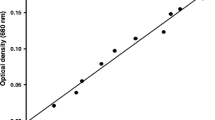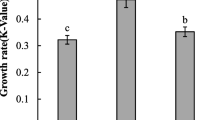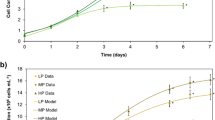Abstract
The understanding of how nitrogen (N) to phosphorus (P) ratios regulate growth and chemical composition of algae is important to control the nutritional value of microalgae for industrial application. This study compared the impacts of N:P ratio manipulations on the growth, elements, lipid, fatty acids and protein contents of Tisochrysis lutea and Nannochloropsis oculata. F/2 medium was used as the basal formula to obtained six N:P ratios of 5:1, 10:1, 20:1, 30:1, 60:1 and 120:1 and tested on the algae species in triplicate. Growth rate was similar in both algal species across all N:P ratios, and the carbon content in T. lutea was higher than in N. oculata. However, the carbon contents were high in the N:P ratios of 5:1 and 120:1 and low from 10:1 to 60:1 N:P ratios for both T. lutea and N. oculata. There were no significant differences in cellular N and P, but the protein contents depended on algae species and were significantly affected by N:P ratios. The N:P ratio of 20:1 favoured algal growth and protein content, while the N:P ratio of 120:1 reduced algal growth and protein synthesis but increased lipid in both algae. The 20:1 N:P ratio favoured eicosapentaenoic acid (EPA) production in N. oculata and the 30:1 N:P ratio favours docosahexaenoic acid (DHA) production in T. lutea. This study indicates that N:P ratio manipulation is an effective strategy to change biochemical composition in algae and N or P limitation tends to lower polyunsaturated fatty acids (PUFA) contents in algae.




Similar content being viewed by others
References
Ahlgren G, Hyenstrand P (2003) Nitrogen limitation effects of different nitrogen sources on nutritional quality of two freshwater organisms, Scenedesmus quadricauda (Chlorophyceae) and Synechococcus sp. (Cyanophyceae). J Phycol 39:906–917
Anderson TR, Pond DW (2000) Stoichiometric theory extended to micronutrients: comparison of the roles of essential fatty acids, carbon, and nitrogen in the nutrition of marine copepods. Limnol Oceanogr 45:1162–1167
Barbarino E, Lourenço S (2005) An evaluation of methods for extraction and quantification of protein from marine macro- and microalgae. J Appl Phycol 17:447–460
Beardall J, Berman T, Heraud P, Omo Kadiri M, Light BR, Patterson G, Roberts S, Sulzberger B, Sahan E, Uehlinger U, Wood B (2001a) A comparison of methods for detection of phosphate limitation in microalgae. Aquat Sci 63:107–121
Beardall J, Young E, Roberts S (2001b) Approaches for determining phytoplankton nutrient limitation. Aquat Sci 63:44–69
Berdalet E, Latasa M, Estrada M (1994) Effects of nitrogen and phosphorus starvation on nucleic acid and protein content of Heterocapsa sp. J Plankton Res 16:303–316
Bendif EM, Probert I, Schroeder DC, de Vargas C (2013) On the description of Tisochrysis lutea gen. nov. sp. nov. and Isochrysis nuda sp. nov. in the Isochrysidales, and the transfer of Dicrateria to the Prymnesiales (Haptophyta). J Appl Phycol 25:1763–1776
Bigogno C, Khozin-Goldberg I, Boussiba S, Vonshak A, Cohen Z (2002) Lipid and fatty acid composition of the green oleaginous alga Parietochloris incisa, the richest plant source of arachidonic acid. Phytochemistry 60:497–503
Bligh EG, Dyer WJ (1959) A rapid method of total lipid extraction and purification. Can J Biochem Physiol 37:911–917
Borowitzka MA (1997) Microalgae for aquaculture: opportunities and constraints. J Appl Phycol 9:393–401
Borowitzka MA (2013) High-value products from microalgae—their development and commercialisation. J Appl Phycol 25:743–756
Breteler WCMK, Schogt N, Rampen S (2005) Effect of diatom nutrient limitation on copepod development: role of essential lipids. Mar Ecol Prog Ser 291:125–133
Breuer G, Lamers PP, Martens DE, Draaisma RB, Wijffels RH (2012) The impact of nitrogen starvation on the dynamics of triacylglycerol accumulation in nine microalgae strains. Bioresource Technol 124:217–226
Brown MR, Hohmann S (2002) Effects of irradiance and growth phase on the ascorbic acid content of Isochrysis sp. T.ISO (Prymnesiophyta). J Appl Phycol 14:211–214
Cembella AD, Antia NJ, Harrison PJ (1984) The utilization of inorganic and organic phosphorus compounds as nutrients by eukaryotic microalgae—a multidisciplinary perspective. Crit Rev Microbiol 11:13–81
Claquin P, Martin-Jézéquel V, Kromkamp JC, Veldhuis MJW, Kraay GW (2002) Uncoupling of silicon compared with carbon and nitrogen metabolisms and the role of the cell cycle in continuous cultures of Thalassiosira pseudonana (Bacillariophyceae) under light, nitrogen, and phosphorus control. J Phycol 38:922–930
Clark DR, Flynn KJ, Owens NJP (2002) The large capacity for dark nitrate-assimilation in diatoms may overcome nitrate limitation of growth. New Phytol 155:101–108
Coutteau P, Castell JD, Ackman RG, Sorgeloos P (1996) The use of lipid emulsions as carriers for essential fatty acids in bivalves: a test case with juvenile Placopecten magellanicus. J Shellfish Res 15:259–264
Douillet PA, Langdon CJ (1994) Use of a probiotic for the culture of larvae of the pacific oyster (Crassostrea gigas). Aquaculture 119:25–40
Downing TG, Sember CS, Gehringer MM, Leukes W (2005) Medium N:P ratios and specific growth rate comodulate microcystin and protein content in Microcystis aeruginosa PCC7806 and M. aeruginosa UV027. Microb Ecol 49:468–473
Duerr EO, Molnar A, Sato V (1998) Cultured microalgae as aquaculture feeds. J Mar Biotechnol 6:65–70
Ferrão-Filho AS, Fileto C, Lopes NP, Arcifa MS (2003) Effects of essential fatty acids and N and P-limited algae on the growth rate of tropical cladocerans. Freshwater Biol 48:759–767
Fidalgo JP, Cid A, Torres E, Sukenik A, Herrero C (1998) Effects of nitrogen source and growth phase on proximate biochemical composition, lipid classes and fatty acid profile of the marine microalga Isochrysis galbana. Aquaculture 166:105–116
Flores E, Herrero A (2004) Assimilatory nitrogen metabolism and its regulation. In: Bryant D (ed) The Molecular Biology of Cyanobacteria, vol 1, Advances in Photosynthesis and Respiration. Springer, Dordrecht, pp 487–517
Flynn T, Ghirardi ML, Seibert M (2002) Accumulation of O2-tolerant phenotypes in H2-producing strains of Chlamydomonas reinhardtii by sequential applications of chemical mutagenesis and selection. Int J Hydrogen Ener 27:1421–1430
Fong P, Fong JJ, Fong CR (2004) Growth, nutrient storage, and release of dissolved organic nitrogen by Enteromorpha intestinalis in response to pulses of nitrogen and phosphorus. Aquat Bot 78:83–95
Fresnedo O, Serra JL (1992) Effect of nitrogen starvation on the biochemistry of Phormidium laminosum (Cyanophyceae). J Phycol 28:786–793
Ganf GG, Stone SJL, Oliver RL (1986) Use of protein to carbohydrate ratios to analyze for nutrient deficiency in phytoplankton. Aust J Mar Fresh Res 37:183–197
Geider R, La Roche J (2002) Redfield revisited: variability of C:N:P in marine microalgae and its biochemical basis. Eur J Phycol 37:1–17
Gordillo FJL, Goutx M, Figueroa FL, Niell FX (1998) Effects of light intensity, CO2 and nitrogen supply on lipid class composition of Dunaliella viridis. J Appl Phycol 10:135–144
Harrison PJ, Thompson PA, Calderwood GS (1990) Effects of nutrient and light limitation on the biochemical composition of phytoplankton. J Appl Phycol 2:45–56
Healey FP, Hendzel LL (1979) Indicators of phosphorus and nitrogen deficiency in 5 algae in culture. J Fish Res Board Can 36:1364–1369
Hessen DO, Færøvig PJ, Andersen T (2002) Light, nutrients, and P:C ratios in algae: grazer performance related to food quality and quantity. Ecology 83:1886–1898
Hu Q, Sommerfeld M, Jarvis E, Ghirardi M, Posewitz M, Seibert M, Darzins A (2008) Microalgal triacyglycerols as feedstocks for biofuel production: perspectives and advances. Plant J 54:621–639
Johansson N, Graneli E (1999) Cell density, chemical composition and toxicity of Chrysochromulina polylepis (Haptophyta) in relation to different N : P supply ratios. Mar Biol 135:209–217
Jonasdottir SH, Visser A, Jespersen C (2009) Assessing the role of food quality in the production and hatching of Temora longicornis eggs. Mar Ecol Prog Ser 382:139–150
Kilham S, Kreeger D, Goulden C, Lynn S (1997) Effects of nutrient limitation on biochemical constituents of Ankistrodesmus falcatus. Freshwater Biol 38:591–596
Knauer J, Southgate PC (1997) Growth and fatty acid composition of Pacific oyster (Crassostrea gigas) spat fed a microalga and microcapsules containing varying amounts of eicosapentaenoic and docosahexaenoic acid. J Shellfish Res 16:447–453
Kunikane S, Kaneko M, Maehara R (1984) Growth and nutrient uptake of green alga, Scenedesmus dimorphus, under a wide range of nitrogen/phosphorus ratio—I. Experimental study. Water Res 18:1299–1311
Lai J, Yu Z, Song X, Cao X, Han X (2011) Responses of the growth and biochemical composition of Prorocentrum donghaiense to different nitrogen and phosphorus concentrations. J Exp Mar Biol Ecol 405:6–17
Lagus A, Suomela J, Weithoff G, Heikkilä K, Helminen H, Sipura J (2004) Species-specific differences in phytoplankton responses to N and P enrichments and the N: P ratio in the Archipelago Sea, northern Baltic Sea. J Plankton Res 26:779–798
Langer G, Oetjen K, Brenneis T (2012) Calcification of Calcidiscus leptoporus under nitrogen and phosphorus limitation. J Exp Mar Biol Ecol 413:131–137
Li Y, Qin JG (2005) Comparison of growth and lipid content in three Botryococcus braunii strains. J Appl Phycol 17:551–556
Liang K, Zhang Q, Gu M, Cong W (2013) Effect of phosphorus on lipid accumulation in freshwater microalga Chlorella sp. J Appl Phycol 25:311–318
C-Pa L, Lin L-P (2001) Ultrastructural study and lipid formation of Isochrysis sp. Bot Bull Acad Sinica 42:207–214
Liu Y, Song X, Cao X, Yu Z (2013) Responses of photosynthetic characters of Skeletonema costatum to different nutrient conditions. J Plankton Res 35:165–176
Mayers JJ, Flynn KJ, Shields RJ (2014) Influence of the N:P supply ratio on biomass productivity and time-resolved changes in elemental and bulk biochemical composition of Nannochloropsis sp. Bioresource Technol 169:588–595
Mansour M, Frampton DF, Nichols P, Volkman J, Blackburn S (2005) Lipid and fatty acid yield of nine stationary-phase microalgae: applications and unusual C24–C28 polyunsaturated fatty acids. J Appl Phycol 17:287–300
Marchetti J, Bougaran G, Le Dean L, Mégrier C, Lukomska E, Kaas R, Olivo E, Baron R, Robert R, Cadoret JP (2012) Optimizing conditions for the continuous culture of Isochrysis affinis galbana relevant to commercial hatcheries. Aquaculture 326–329:106–115
Martínez-Fernández E, Acosta-Salmón H, Southgate PC (2006) The nutritional value of seven species of tropical microalgae for black-lip pearl oyster (Pinctada margaritifera, L.) larvae. Aquaculture 257:491–503
McCausland MA, Brown MR, Barrett SM, Diemar JA, Heasman MP (1999) Evaluation of live microalgae and microalgal pastes as supplementary food for juvenile Pacific oysters (Crassostrea gigas). Aquaculture 174:323–342
Mueller-Navarra DC, Brett MT, Liston AM, Goldman CR (2000) A highly unsaturated fatty acid predicts carbon transfer between primary producers and consumers. Nature 403:74–77
Nalewajko C, Lee K, Shear H (1981) Phosphorus kinetics in lake superior—light intensity and phosphate uptake in algae. Can J Fish Aquat Sci 38:224–232
Nell JA (2002) Farming triploid oysters. Aquaculture 210:69–88
Patil V, Källqvist T, Olsen E, Vogt G, Gislerød H (2007) Fatty acid composition of 12 microalgae for possible use in aquaculture feed. Aquacult Int 15:1–9
Pulz O, Gross W (2004) Valuable products from biotechnology of microalgae. Appl Microbiol Biotechnol 65:635–648
Qin JG, Culver DA (1996) Effect of larval fish and nutrient enrichment on plankton dynamics in experimental ponds. Hydrobiologia 321:109–118
Qin S, Lin HZ, Jiang P (2012) Advances in genetic engineering of marine algae. Biotechnol Adv 30:1602–1613
Ratledge C, Wynn JP (2002) The biochemistry and molecular biology of lipid accumulation in oleaginous microorganisms. Adv Appl Microbiol 51:1–51
Redfield AC (1934) On the proportions of organic derivatives in sea water and their relation to the composition of plankton. In: Daniel RJ (ed) James Johnstone Memorial Volume. Liverpool University Press, Liverpool, pp 176–192
Reitan KI, Rainuzzo JR, Olsen Y (1994) Effect of nutrient limitation on fatty acid and lipid content of marine microalgae. J Phycol 30:972–979
Rhee GY (1978) Effects of N:P atomic ratios and nitrate limitation on algal growth, cell composition, and nitrate uptake. Limnol Oceanogr 23:10–25
Robert R, Parisi G, Rodolfi L, Poli BM, Tredici MR (2001) Use of fresh and preserved Tetraselmis suecica for feeding Crassostrea gigas larvae. Aquaculture 192:333–346
Robert R, Trintignac P (1997) Substitutes for live microalgae in mariculture: a review. Aquat Liv Res 10:315–327
Rodolfi GC, Bassi ZN, Padovani G, Biondi N, Bonini G, Tredici MR (2009) Microalgae for oil: strain selection, induction of lipid synthesis and outdoor mass cultivation in a low-cost photobioreactor. Biotechnol Bioeng 102:100–112
Rosenberg JN, Oyler GA, Wilkinson L, Betenbaugh MJ (2008) A green light for engineered algae: redirecting metabolism to fuel a biotechnology revolution. Curr Opin Biotechnol 19:430–436
Sharma KK, Schuhmann H, Schenk PM (2012) High lipid induction in microalgae for biodiesel production. Energies 5:1532–1553
Shifrin NS, Chisholm SW (1981) Phytoplankton lipids—interspecific differences and effects of nitrate, silicate and light-dark cycles. J Phycol 17:374–384
Solovchenko AE, Khozin-Goldberg I, Didi-Cohen S, Cohen Z, Merzlyak MN (2008) Effects of light intensity and nitrogen starvation on growth, total fatty acids and arachidonic acid in the green microalga Parietochloris incisa. J Appl Phycol 20:245–251
Sterner RW, Hessen DO (1994) Algal nutrient limitation and the nutrition of aquatic herbivores. Ann Rev Ecol System 25:1–29
Sun J, Liu D, Chan Z, Wei T (2004) Growth of Platymonas helgolandica var. tsingtaoensis, Cylindrotheca closterium and Karenia mikimotoi and their survival strategies under different N/P ratios. J Appl Ecol 15:2122–2126
Suzuki T, Imai M, Ishida M (1997) Influence of environmental factors on phosphorous content in the marine microalga Dunaliella. Environ Toxicol Chem 64:173–181
Takagi M, Karseno YT (2006) Effect of salt concentration on intracellular accumulation of lipids and triacylglyceride in marine microalgae Dunaliella cells. J Biosci Bioeng 101:223–226
Theodorou ME, Elrifi IR, Turpin DH, Plaxton WC (1991) Effects of phosphorus limitation on respiratory metabolism in the green alga Selenastrum minutum. Plant Physiol 95:1089–1095
Tornabene TG, Holzer G, Lien S, Burris N (1983) Lipid-composition of the nitrogen starved green alga Neochloris oleoabundans. Enzyme Microb Tech 5:435–440
Vanucci S, Pezzolesi L, Pistocchi R, Ciminiello P, Dell’Aversano C, Iacovo ED, Fattorusso E, Tartaglione L, Guerrini F (2012) Nitrogen and phosphorus limitation effects on cell growth, biovolume, and toxin production in Ostreopsis cf. ovata. Harmful Algae 15:78–90
Vidyarathna NK, Granéli E (2013) Physiological responses of Ostreopsis ovata to changes in N and P availability and temperature increase. Harmful Algae 21–22:54–63
Villar-Argaiz M, Sterner RW (2002) Life history bottlenecks in Diaptomus clavipes induced by phosphorus-limited algae. Limnol Oceanog 47:1229–1233
Wheal MS, Fowles TO, Palmer LT (2011) A cost-effective acid digestion method using closed polypropylene tubes for inductively coupled plasma optical emission spectrometry (ICP-OES) analysis of plant essential elements. Anal Methods-UK 3:2854–2863
Zhang Q, Hu G (2011) Effect of nitrogen to phosphorus ratios on cell proliferation in marine micro algae. Chin J Oceanol Limn 29:739–745
Zhao XW, Tang XX, Wang Y (2009) Interactions between two species of marine bloom microalgae under controlled laboratory conditions: Heterosigma akashiwo and Karenia mikimotoi. Chinese J Plant Ecol 33:958–965
Acknowledgments
We wish to thank Leslie Morrison, Dominic Reppucci, Julie Voyer, Ralphael Livingstone and Brett Norsworthy for their kind advice and facilities support. This study was supported by a PhD scholarship to Nadiah Rasdi by the Malaysian Government.
Author information
Authors and Affiliations
Corresponding author
Rights and permissions
About this article
Cite this article
Rasdi, N.W., Qin, J.G. Effect of N:P ratio on growth and chemical composition of Nannochloropsis oculata and Tisochrysis lutea . J Appl Phycol 27, 2221–2230 (2015). https://doi.org/10.1007/s10811-014-0495-z
Received:
Revised:
Accepted:
Published:
Issue Date:
DOI: https://doi.org/10.1007/s10811-014-0495-z




